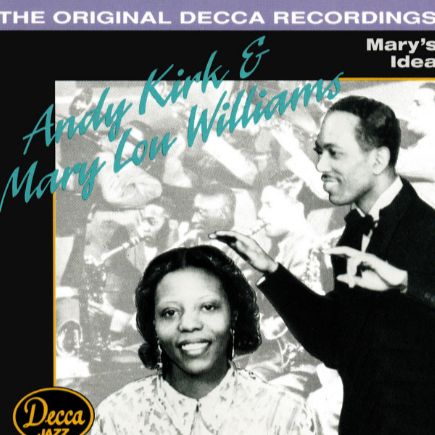Andy Kirk: l’élégance orchestrale du swing de Kansas City
Saxophoniste baryton, tubiste et chef d’orchestre, Andy Kirk occupe une place singulière dans l’histoire du jazz américain. Moins médiatisé que certains de ses contemporains, il fut pourtant l’un des artisans essentiels du développement du Kansas City Sound et de la diffusion du swing raffiné des années 1930 et 1940.
Né à Newport, dans le Kentucky, et élevé à Denver, Andy Kirk se forme au tuba et au saxophone alto avant de devenir un leader respecté. Après ses débuts auprès de Terrence Holder, il prend la direction de son orchestre en 1929 et le rebaptise Andy Kirk and His Twelve Clouds of Joy. Le nom fait référence à la taille relativement modeste de la formation, qui se distingue pourtant par une richesse sonore et un équilibre d’ensemble exceptionnels.
Au cœur de ce big band, la présence de Mary Lou Williams joue un rôle décisif. Pianiste, compositrice et arrangeuse d’un génie visionnaire, elle devient l’âme du groupe, lui apportant une modernité harmonique et un sens du swing inédits. Ses arrangements audacieux, combinant lyrisme et complexité, annoncent certaines évolutions qui influenceront Duke Ellington ou Count Basie. Sous sa plume, des morceaux comme Walkin’ and Swingin’ ou Cloudy illustrent parfaitement l’identité du groupe: un swing fluide, précis, élégant, où chaque instrument contribue à une texture orchestrale d’une remarquable finesse.
Le style d’Andy Kirk repose moins sur la virtuosité individuelle que sur l’art du collectif. Son orchestre privilégie la souplesse du rythme, la lisibilité des arrangements et une expressivité contenue, loin de la rugosité plus spontanée d’autres formations de Kansas City. Cette approche lui permet d’explorer un large répertoire, mêlant titres instrumentaux raffinés et ballades vocales d’une grande sensibilité. Des enregistrements comme Floyd’s Guitar Blues – où la guitare slide occupe un rôle inattendu – ou Until the Real Thing Comes Along – avec ses harmonies vocales subtiles – témoignent de cette diversité et de sa capacité à concilier innovation et accessibilité.
Durant l’âge d’or du swing, The Twelve Clouds of Joy rivalisent avec les plus grands big bands, imposant un modèle d’équilibre entre sophistication orchestrale et chaleur populaire. Mais comme beaucoup d’ensembles de cette époque, l’après-guerre marque leur déclin face à l’essor du bebop et aux bouleversements de l’industrie musicale. Andy Kirk choisit alors de se retirer progressivement de la scène, se consacrant à des activités administratives et éducatives dans le domaine musical.
Andy Kirk: la elegancia orquestal del swing de Kansas City
Saxofonista barítono, tubista y director de orquesta, Andy Kirk ocupa un lugar singular en la historia del jazz estadounidense. Menos mediático que algunos de sus contemporáneos, fue sin embargo uno de los artífices esenciales del desarrollo del Kansas City Sound y de la difusión de un swing refinado durante las décadas de 1930 y 1940.
Nacido en Newport, Kentucky, y criado en Denver, Andy Kirk se formó en la tuba y el saxofón alto antes de convertirse en un líder respetado. Tras sus comienzos junto a Terrence Holder, asumió la dirección de su orquesta en 1929 y la rebautizó como Andy Kirk and His Twelve Clouds of Joy. El nombre hacía referencia al tamaño relativamente reducido del conjunto, que sin embargo se distinguía por su riqueza sonora y su equilibrio excepcional.
En el corazón de este big band, la presencia de Mary Lou Williams desempeñó un papel decisivo. Pianista, compositora y arreglista de genio visionario, se convirtió en el alma del grupo, aportándole una modernidad armónica y un sentido del swing inéditos. Sus arreglos audaces, combinando lirismo y complejidad, anunciaron evoluciones que más tarde influirían en Duke Ellington y Count Basie. Bajo su pluma, piezas como Walkin’ and Swingin’ o Cloudy ilustran perfectamente la identidad del grupo: un swing fluido, preciso y elegante, donde cada instrumento contribuye a una textura orquestal de notable finura.
El estilo de Andy Kirk se apoyaba menos en la virtuosidad individual que en el arte del colectivo. Su orquesta privilegiaba la flexibilidad rítmica, la claridad de los arreglos y una expresividad contenida, lejos de la energía más ruda de otras formaciones de Kansas City. Esta visión le permitió explorar un amplio repertorio que combinaba piezas instrumentales sofisticadas con baladas vocales de gran sensibilidad. Grabaciones como Floyd’s Guitar Blues —donde la guitarra slide ocupa un papel inusual— o Until the Real Thing Comes Along —con sus armonías vocales sutiles— testimonian esta diversidad y su capacidad para conciliar innovación y accesibilidad.
Durante la edad de oro del swing, The Twelve Clouds of Joy rivalizaron con las mejores big bands, imponiendo un modelo de equilibrio entre sofisticación orquestal y calidez popular. Pero, como muchos conjuntos de la época, la posguerra marcó su declive ante el auge del bebop y las transformaciones de la industria musical. Andy Kirk decidió retirarse progresivamente de los escenarios para dedicarse a actividades administrativas y educativas en el ámbito musical.
Andy Kirk: l’eleganza orchestrale dello swing di Kansas City
Sassofonista baritono, tubista e direttore d’orchestra, Andy Kirk occupa un posto singolare nella storia del jazz americano. Meno mediatico di alcuni suoi contemporanei, fu tuttavia uno degli artefici principali dello sviluppo del Kansas City Sound e della diffusione di uno swing raffinato durante gli anni Trenta e Quaranta.
Nato a Newport, nel Kentucky, e cresciuto a Denver, Andy Kirk studiò tuba e sassofono contralto prima di affermarsi come leader rispettato. Dopo gli inizi con Terrence Holder, assunse la direzione della sua orchestra nel 1929, ribattezzandola Andy Kirk and His Twelve Clouds of Joy. Il nome faceva riferimento alle dimensioni relativamente ridotte dell’ensemble, che tuttavia si distingueva per la ricchezza timbrica e l’equilibrio sonoro.
Al centro di questa big band, la presenza di Mary Lou Williams ebbe un ruolo decisivo. Pianista, compositrice e arrangiatrice dal genio visionario, divenne l’anima del gruppo, conferendogli una modernità armonica e un senso dello swing inediti. I suoi arrangiamenti audaci, che univano lirismo e complessità, anticiparono sviluppi che avrebbero influenzato Duke Ellington e Count Basie. Brani come Walkin’ and Swingin’ o Cloudy rappresentano perfettamente l’identità del gruppo: uno swing fluido, preciso ed elegante, dove ogni strumento contribuisce a una tessitura orchestrale di straordinaria finezza.
Lo stile di Andy Kirk si basava meno sulla virtuosità individuale che sull’arte del collettivo. La sua orchestra privilegiava la flessibilità ritmica, la chiarezza degli arrangiamenti e un’espressività controllata, lontana dall’energia più ruvida di altre formazioni di Kansas City. Questa visione gli permise di esplorare un vasto repertorio che univa composizioni strumentali raffinate e ballate vocali di grande sensibilità. Registrazioni come Floyd’s Guitar Blues —dove la chitarra slide assume un ruolo inusuale— o Until the Real Thing Comes Along —con le sue sottili armonie vocali— testimoniano la sua capacità di conciliare innovazione e accessibilità.
Durante l’età d’oro dello swing, The Twelve Clouds of Joy rivaleggiarono con le migliori big band, imponendo un modello di equilibrio tra sofisticazione orchestrale e calore popolare. Ma, come molte formazioni dell’epoca, il dopoguerra segnò il loro declino di fronte all’ascesa del bebop e ai cambiamenti dell’industria musicale. Andy Kirk decise allora di ritirarsi progressivamente dalle scene per dedicarsi ad attività amministrative ed educative nel campo musicale.
Andy Kirk: the orchestral elegance of Kansas City swing
Baritone saxophonist, tubist, and bandleader Andy Kirk holds a unique place in the history of American jazz. Less publicized than some of his contemporaries, he was nonetheless one of the key architects of the Kansas City Sound and of the refined swing that flourished in the 1930s and 1940s.
Born in Newport, Kentucky, and raised in Denver, Andy Kirk trained on the tuba and alto saxophone before becoming a respected leader. After his early work with Terrence Holder, he took over the band in 1929 and renamed it Andy Kirk and His Twelve Clouds of Joy. The name referred to the relatively small size of the group, which nevertheless stood out for its remarkable sonic richness and ensemble balance.
At the heart of this big band was the extraordinary presence of Mary Lou Williams. A pianist, composer, and arranger of visionary talent, she became the soul of the ensemble, bringing harmonic modernity and an innovative sense of swing. Her daring arrangements—combining lyricism and sophistication—foreshadowed developments that would later influence Duke Ellington and Count Basie. Under her pen, pieces such as Walkin’ and Swingin’ and Cloudy perfectly capture the group’s identity: a smooth, precise, and elegant swing, where each instrument contributes to a refined orchestral texture.
Andy Kirk’s style relied less on individual virtuosity than on the art of collective sound. His orchestra emphasized rhythmic flexibility, clarity of arrangement, and a restrained expressiveness, far from the raw energy of other Kansas City bands. This approach allowed him to explore a wide repertoire, blending intricate instrumental numbers with lyrical vocal ballads. Recordings such as Floyd’s Guitar Blues—featuring an unusually prominent slide guitar—and Until the Real Thing Comes Along—with its subtle vocal harmonies—reflect both the band’s diversity and its balance between innovation and accessibility.
During the swing era’s golden age, The Twelve Clouds of Joy rivaled the leading big bands of the time, embodying a perfect balance between orchestral sophistication and popular warmth. Yet, like many ensembles of that period, the postwar years brought decline amid the rise of bebop and shifts in the music industry. Andy Kirk gradually withdrew from performing, devoting himself to administrative and educational work within the musical field.


